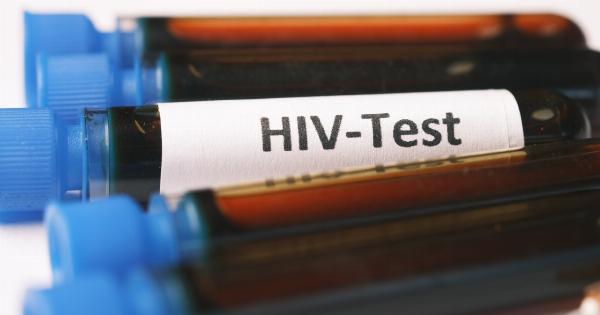HIV (Human Immunodeficiency Virus) and AIDS (Acquired Immunodeficiency Syndrome) are two terms that are often used interchangeably, but they are actually two distinct conditions.
Understanding the difference between these two conditions is essential for proper diagnosis, treatment, and prevention.
What is HIV?
HIV is a virus that attacks the immune system. It primarily targets CD4 cells, which are white blood cells that play a crucial role in the immune system’s response to infections.
HIV gradually destroys CD4 cells and weakens the immune system, leaving the person vulnerable to various infections and cancers.
HIV is transmitted through blood, semen, vaginal fluids, and breast milk. The most common modes of transmission are unprotected sex, sharing needles, and mother-to-child transmission during pregnancy, childbirth, or breastfeeding.
HIV infection progresses in stages over time. The initial stage is acute infection, which may cause flu-like symptoms like fever, headache, muscle aches, and rash. However, many people do not show any symptoms at this stage.
After a few weeks to months, HIV enters the chronic or asymptomatic stage where the virus replicates slowly and steadily.
The person may not experience any symptoms at this stage, but the virus is still actively damaging the immune system, and the person can still transmit the virus to others.
If left untreated, HIV infection can lead to AIDS, which is the final stage of the disease.
What is AIDS?
AIDS is a stage of HIV infection where the immune system is severely damaged, and the person becomes vulnerable to opportunistic infections and cancers.
AIDS is diagnosed when a person’s CD4 cell count drops below 200 per cubic millimeter (mm3) of blood or when they develop certain opportunistic infections or cancers.
Without treatment, people with AIDS typically survive for only three years. However, with appropriate treatment, people with AIDS can live for many years with a good quality of life.
What are the symptoms of AIDS?
As AIDS is a collection of opportunistic infections and cancers, its symptoms can vary widely depending on the specific infection or cancer that the person develops. Some common AIDS-related opportunistic infections and their symptoms are:.
- Pneumocystis pneumonia: fever, dry cough, shortness of breath, chest pain
- Cryptococcal meningitis: headache, fever, neck stiffness, blurred vision, confusion, nausea, vomiting
- Kaposi’s sarcoma: purple, red, or brown blotches or bumps on the skin, mouth, or rectum
- Cytomegalovirus (CMV) retinitis: blurry vision, floaters, flashes of light, blind spots, blindness
Note that these infections are rare in people with healthy immune systems, but they can be life-threatening in people with AIDS.
How is HIV diagnosed and treated?
HIV is diagnosed through a blood test that detects HIV antibodies or the virus itself. The test is usually accurate three to four weeks after exposure.
People at high risk for HIV, such as those who have unprotected sex or share needles, should get tested at least once a year.
HIV is treated with antiretroviral therapy (ART), which involves taking a combination of medications that target different stages of the virus’s life cycle.
ART can suppress the virus to undetectable levels in the blood and prevent HIV-related complications, including AIDS. However, ART does not cure HIV, and people need to take the medications for life.
People with HIV also need to make lifestyle changes, such as practicing safe sex, not sharing needles, and taking care of their overall health.
They should get vaccinated against other infections like flu and pneumonia and get regular check-ups to monitor their HIV status and health.
How is AIDS diagnosed and treated?
AIDS is diagnosed based on a person’s symptoms, CD4 cell count, and presence of certain opportunistic infections or cancers. Once diagnosed with AIDS, the person needs specialized medical care to manage the AIDS-related complications.
Treatment typically involves a combination of medications to target the specific opportunistic infections or cancers and ART to suppress the HIV virus and prevent further damage to the immune system. People with AIDS also need close monitoring and frequent check-ups to manage their condition effectively.
Preventing HIV and AIDS
The best way to prevent HIV and AIDS is through prevention measures like:.
- Practicing safe sex, such as using condoms or pre-exposure prophylaxis (PrEP) medication
- Not sharing needles or other injection equipment
- Using sterile equipment for tattoos and piercings
- Getting tested for HIV and other sexually transmitted infections (STIs) regularly
- Taking ART medication if diagnosed with HIV
Education and awareness also play a crucial role in preventing HIV and AIDS. People need to understand the risks and modes of transmission of HIV and how to protect themselves and their partners from infection.
Conclusion
HIV and AIDS are two distinct yet linked conditions that affect millions of people worldwide.
HIV is a virus that attacks the immune system, while AIDS is the final stage of HIV infection where the immune system is severely damaged, and the person becomes vulnerable to opportunistic infections and cancers. Early diagnosis and treatment of HIV can prevent progression to AIDS and improve the person’s life expectancy and quality of life. Prevention measures like safe sex, not sharing needles, and awareness can help prevent HIV and AIDS.



























